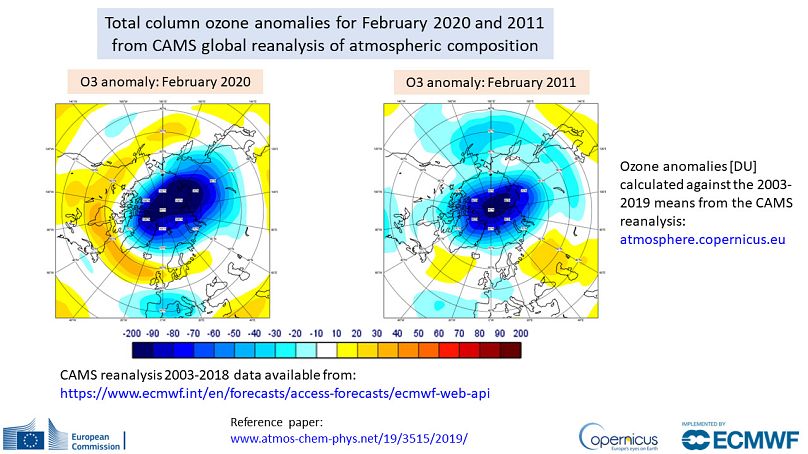A rare ozone hole has opened up over the Arctic this winter. But the layer over the Antarctic is improving.
Proving they are truly poles apart, the ozone layer over the Arctic has surprised scientists by plunging to historic levels, while the ozone layer over the Antarctic goes from strength to strength. The findings cast new light on the interactions between the ozone layer and atmospheric circulation disruptions caused by human induced climate change.
The Copernicus Atmosphere Monitoring Service acknowledges that seeing such a hole in the North Pole's ozone layer like the one of this year is "very unusual. Normally, we don't see this level of ozone depletion in the Arctic during the Northern Hemisphere spring".
The Atmospheric Composition Monitoring service from the European Organisation for the Exploitation of Meteorological Satellites warned last week of "dramatic ozone loss" over the Arctic this month.
"Usually the ozone hole is in the Antarctic in spring [September]. This year, due to special meteorological conditions, an ozone depletion is observed also over the northern polar region," it explained.
Ozone depletion is directly related to the temperature in the stratosphere. Ozone is destroyed by chemical reactions in stratospheric clouds which can only form at temperatures below -80°C.
But the polar vortex, which maintains cold air around the Arctic, has remained exceptionally strong and stable at colder temperatures than usual this winter and spring, favouring ozone loss.
On Sunday, scientists noted, for instance, that they could "still see temperatures below -75C at hPa (hectopascals)."
"The total ozone above the North Pole was more than 100 DU (dobson units) below the average and the anomaly was greater than in 2011," scientists from the Copernicus programme noted. The 2011 one was the first and biggest Arctic ozone hole observed to that date.
They European Earth monitoring programme expects ozone values to recover as the stratosphere warms up and when the polar vortex disperses. Temperatures have already started to rise.
Countries under this hole are exposed to increased ultraviolet radiation.
The Arctic ozone hole can have impacts on atmospheric circulation — the large-scale movement of air that causes winds and distributes thermal energy around the globe.
Antarctica improvement sheds new light on climate change
Meanwhile, on the other side of the globe, the hole above the South Pole is at historical lows, partly due to a record sudden stratospheric warming event.
A study published in Nature found that the 1987 ban on Ozone Depleting Substances (ODS) as part of the Montreal Protocol has led to the recovery of the southern jet stream — a narrow band of strong winds shaping weather patterns and ocean current in the southern hemisphere.
The scientists found that since the year 2000, the southern jet stream has stopped moving southwards and that this was caused by an improvement in the ozone layer over the pole.
"The recovery of stratospheric ozone — as a result of the Montreal protocol [which prohibited the use of ODS] - is the engine of the observed pause" in the jet stream's poleward shift, the paper noted.
It added that the situation should continue to improve and that "the consequences of the Montreal Protocol for tropospheric circulation should become even more evident in the future. The pause (which is generally expected from the model results) is just beginning to emerge in the observations".
Jet stream deviation affects marine currents, wind, and precipitation in the southern hemisphere from South America to East Africa and Australia.
If the trend continues, places like Patagonia or Australia, the latter of which has sweltered under months-long drought, could begin to receive more rains, for example.












